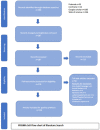Diagnostic Differentiation between Pancreatitis and Pancreatic Cancer: A Scoping Review
- PMID: 38337806
- PMCID: PMC10855106
- DOI: 10.3390/diagnostics14030290
Diagnostic Differentiation between Pancreatitis and Pancreatic Cancer: A Scoping Review
Abstract
Pancreatitis, encompassing acute and chronic forms, and pancreatic cancer pose significant challenges to the exocrine tissue of the pancreas. Recurrence rates and complications following acute pancreatitis episodes can lead to long-term risks, including diabetes mellitus. Chronic pancreatitis can develop in approximately 15% of cases, regardless of the initial episode's severity. Alcohol-induced pancreatitis, idiopathic causes, cigarette smoking, and hereditary pancreatitis contribute to the progression to chronic pancreatitis. Chronic pancreatitis is associated with an increased risk of pancreatic cancer, with older age at onset and smoking identified as risk factors. This scoping review aims to synthesise recent publications (2017-2022) on the diagnostic differentiation between pancreatitis and pancreatic cancer while identifying knowledge gaps in the field. The review focuses on biomarkers and imaging techniques in individuals with pancreatitis and pancreatic cancer. Promising biomarkers such as faecal elastase-1 and specific chemokines offer non-invasive ways to assess pancreatic insufficiency and detect early biomarkers for chronic pancreatitis. Imaging techniques, including computed tomography (CT), magnetic resonance imaging (MRI), endoscopic ultrasound (EUS), and positron emission tomography (PET), aid in differentiating between chronic pancreatitis and pancreatic cancer. However, accurately distinguishing between the two conditions remains a challenge, particularly when a mass is present in the head of the pancreas. Several knowledge gaps persist despite advancements in understanding the association between pancreatitis and pancreatic cancer, including the correlation between histopathological grading systems, non-invasive imaging techniques, and biomarkers in chronic pancreatitis to determine the risk of progression to pancreatic cancer, as well as differentiating between the two conditions. Further research is necessary to enhance our understanding of these aspects, which can ultimately improve the diagnosis and management of pancreatitis and pancreatic cancer.
Keywords: chronic pancreatitis; pancreatic adenocarcinoma; pancreatic cancer; pancreatic carcinoma; pancreatitis.
Conflict of interest statement
The authors declare no conflicts of interest.
Figures
Similar articles
-
Role of Endoscopic Ultrasound in Detecting Pancreatic Cancer Missed on Cross-Sectional Imaging in Patients Presenting with Pancreatitis: A Retrospective Review.Dig Dis Sci. 2019 Dec;64(12):3623-3629. doi: 10.1007/s10620-019-05807-z. Epub 2019 Sep 16. Dig Dis Sci. 2019. PMID: 31529412
-
Diagnosis and Management of Chronic Pancreatitis: A Review.JAMA. 2019 Dec 24;322(24):2422-2434. doi: 10.1001/jama.2019.19411. JAMA. 2019. PMID: 31860051 Review.
-
Pancreatico-biliary endoscopic ultrasound: a systematic review of the levels of evidence, performance and outcomes.World J Gastroenterol. 2012 Aug 28;18(32):4243-56. doi: 10.3748/wjg.v18.i32.4243. World J Gastroenterol. 2012. PMID: 22969187 Free PMC article. Review.
-
The role of EUS in relation to other imaging modalities in the differential diagnosis between mass forming chronic pancreatitis, autoimmune pancreatitis and ductal pancreatic adenocarcinoma.Rev Esp Enferm Dig. 2012 Jun;104(6):315-21. doi: 10.4321/s1130-01082012000600006. Rev Esp Enferm Dig. 2012. PMID: 22738702 Review.
-
[Faecal elastase I--its use in diagnosis of chronic pancreatitis].Cas Lek Cesk. 2006;145(6):480-3. Cas Lek Cesk. 2006. PMID: 16836002 Czech.
References
Publication types
Grants and funding
LinkOut - more resources
Full Text Sources






